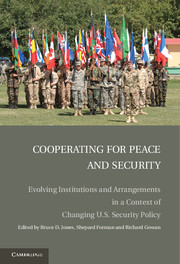 Cooperating for Peace and Security
Cooperating for Peace and Security Book contents
- Frontmatter
- Contents
- Contributors
- Foreword
- Acknowledgments
- I FRAMEWORK
- II ADAPTING COLD WAR INSTITUTIONS
- 4 An Evolving UN Security Council
- 5 Too Many Institutions? European Security Cooperation after the Cold War
- 6 Whither NATO
- 7 The Evolution of Nuclear Nonproliferation Institutions
- 8 9/11, the War on Terror, and the Evolution of Multilateral Institutions
- 9 Evolution and Innovation: Biological and Chemical Weapons
- III NEW TOOLS, NEW MECHANISMS
- IV CONCLUSIONS
- Index
- References
8 - 9/11, the War on Terror, and the Evolution of Multilateral Institutions
Published online by Cambridge University Press: 22 January 2010
- Frontmatter
- Contents
- Contributors
- Foreword
- Acknowledgments
- I FRAMEWORK
- II ADAPTING COLD WAR INSTITUTIONS
- 4 An Evolving UN Security Council
- 5 Too Many Institutions? European Security Cooperation after the Cold War
- 6 Whither NATO
- 7 The Evolution of Nuclear Nonproliferation Institutions
- 8 9/11, the War on Terror, and the Evolution of Multilateral Institutions
- 9 Evolution and Innovation: Biological and Chemical Weapons
- III NEW TOOLS, NEW MECHANISMS
- IV CONCLUSIONS
- Index
- References
Summary
According to conventional wisdom, U.S. counterterrorism policy during the administration of George W. Bush was marked by a high degree of unilateralism. And indeed, the Bush administration's policy revealed a strong ideological predisposition against international rules and standing multilateral institutions, which was exacerbated by the terrorist attacks of 9/11. The “black book” of cases, in which the United States effectively circumvented, abrogated, unsigned from, downgraded, opposed, or undermined standing multilateral treaties and arrangements, is long: from the Conventional Test Ban Treaty to the Anti-Ballistic Missiles Treaty, from the Kyoto Protocol to the Rome Statute on the International Criminal Court, from the United Nations (UN) to the North Atlantic Treaty Organization (NATO). For many observers, the U.S. decision to go to war against Iraq in March 2003 in the absence of an explicit Security Council mandate served as evidence that Washington had nothing but contempt for international rules and norms and multilateral institutions.
Reviewing the Bush administration's approach to multilateral counterterrorism and the evolution of the international institutional architecture in the counterterrorism field during its tenure, this chapter paints a more nuanced picture.
The 2006 U.S. National Strategy for Countering Terrorism ambitiously but misleadingly states: “During the Cold War we created an array of domestic and international institutions and enduring partnerships to defeat the threat of communism. Today, we require similar transformational structures to carry forward the fight against terror.” Of course, 9/11 did not spark anything like a “Dean Acheson moment.
- Type
- Chapter
- Information
- Cooperating for Peace and SecurityEvolving Institutions and Arrangements in a Context of Changing U.S. Security Policy, pp. 143 - 165Publisher: Cambridge University PressPrint publication year: 2009
